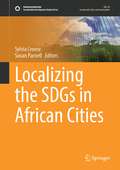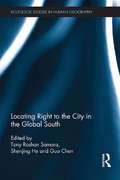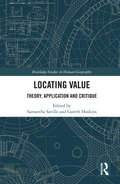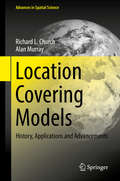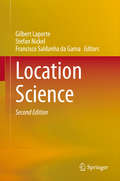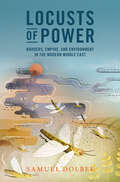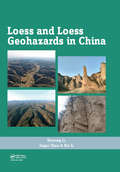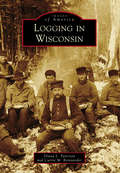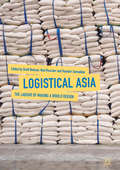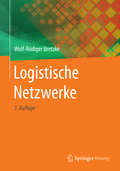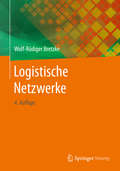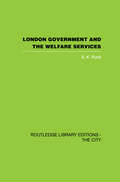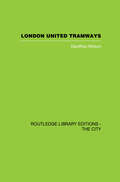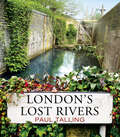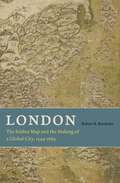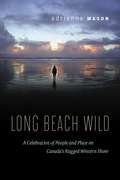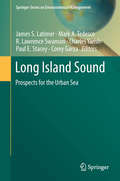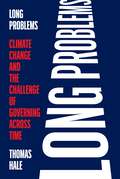- Table View
- List View
Localizing the SDGs in African Cities (Sustainable Development Goals Series)
by Susan Parnell Sylvia CroeseThis volume brings together a unique set of interventions from a variety of contributors to bridge the gap between research and policy with a distinct focus on Africa, drawing on work conducted as part of multiple interconnected research projects and networks on the Sustainable Development Goals (SDGs) and global policy implementation in African cities. Through the framework of the SDGs, and in particular Goal 11, the book aims to contribute to generating new knowledge about approaches to SDG localization that are grounded in complex and diverse local contexts, needs and realities, integrated perspectives and collaborative research. The volume draws together contributions from urban experts from different professional and disciplinary backgrounds, ranging from the fields of governance, planning, data, sustainability, health and finance, to provide critical insight into the current dynamics, actors, blind spots, constraints and also good practices and opportunities for realizing the SDGs in Africa. Readers will gain detailed and informed insight into the African experience of SDG localization, monitoring and implementation based on multiple case studies, and will learn of the practices needed to accelerate action towards achieving the SDGs in urban contexts. This book will be of interest to researchers and planners focusing on SDGs implementation in Africa, as well as government organizations, development practitioners and students committed to long-term, inclusive sustainable and participatory development.
Locating Right to the City in the Global South (Routledge Studies in Human Geography)
by Shenjing He Tony Roshan Samara Guo ChenDespite the fact that virtually all urban growth is occurring, and will continue to occur, in the cities of the Global South, the conceptual tools used to study cities are distilled disproportionately from research on the highly developed cities of the Global North. With urban inequality widely recognized as central to many of the most pressing challenges facing the world, there is a need for a deeper understanding of cities of the South on their own terms. Locating Right to the City in the Global South marks an innovative and far reaching effort to document and make sense of urban transformations across a range of cities, as well as the conflicts and struggles for social justice these are generating. The volume contains empirically rich, theoretically informed case studies focused on the social, spatial, and political dimensions of urban inequality in the Global South. Drawing from scholars with extensive fieldwork experience, this volume covers sixteen cities in fourteen countries across a belt stretching from Latin America, to Africa and the Middle East, and into Asia. Central to what binds these cities are deeply rooted, complex, and dynamic processes of social and spatial division that are being actively reproduced. These cities are not so much fracturing as they are being divided by governance practices informed by local histories and political contestation, and refracted through or infused by market based approaches to urban development. Through a close examination of these practices and resistance to them, this volume provides perspectives on neoliberalism and right to the city that advance our understanding of urbanism in the Global South. In mapping the relationships between space, politics and populations, the volume draws attention to variations shaped by local circumstances, while simultaneously elaborating a distinctive transnational Southern urbanism. It provides indepth research on a range of practical and policy oriented issues, from housing and slum redevelopment to building democratic cities that include participation by lower income and other marginal groups. It will be of interest to students and practitioners alike studying Urban Studies, Globalization, and Development.
Locating Value: Theory, Application and Critique (Routledge Studies in Human Geography)
by Gareth Hoskins Samantha SavilleThis book considers the concept of ‘value’ at the root of our actions and decision-making. Value is an ever-present, yet little interrogated aspect of everyday life. This book explores value as it is theorised, practiced and critiqued from a variety of disciplinary perspectives. It examines how value is operationalized, endorsed and contested in contemporary society. With international insights from leading scholars, chapters offer a diverse and vibrant geographical engagement with value to showcase its conceptual flexibility. The book explores value’s eclectic epistemic foundations; it’s ‘roll-out’ and legitimation across a range of policy fields; and its challenges and opportunities. The book draws on global examples of value in practice: from forest conservation in Indonesia; protected area management in arctic Norway; a state park in the US; certification schemes for biodiversity in the UK; protection of the international night sky; heritage planning in East Taiwan; a re-developed airport site in Norway; a, local food networks in Canada and the UK; a market in the US and urban development in China. The book will be of interest to human geographers, political ecologists, heritage scholars and practitioners, planners and those working in public policy, as well as practitioners and policy makers interested in how valuation processes work.
Location Covering Models: History, Applications and Advancements (Advances in Spatial Science)
by Alan Murray Richard L. ChurchThis book provides a thoughtful and rigorous guide to coverage modeling, reviewing essential models, solution approaches, and related applications. Since the early developments of the Location Set Covering Problem and the Maximal Covering Location Problem, models based upon some form of coverage have been extended and applied in a number of areas, helping to improve services offered to citizens of large cities and regions. Examples include trauma care services, transit systems design, cell tower location, and many others. The book not only describes the strengths and weaknesses of currently available models, but also presents details on major developments, including solution procedures and applications, making it well suited both as a reference text and a textbook for graduate level courses.
Location Science
by Gilbert Laporte Stefan Nickel Francisco Saldanha da GamaThis book presents essential information on modern location science – in a word, all you need to know about location. The second edition of this handbook has been fully revised throughout, with numerous updates and chapters added, to offer an even more comprehensive overview of methods and applications. The book is divided into three parts: basic concepts, advanced concepts and applications. Written by the most respected specialists in the field and thoroughly reviewed by the editors, it first lays out the fundamental problems in location science and provides readers with basic background information on location theory. Part II covers advanced models and concepts, broadening and expanding on the content presented in Part I. It also discusses important tools to help readers grasp and solve real-world location problems. Part III focuses on the links between location science and other areas like GIS, telecommunications, healthcare, rapid transit networks, districting problems and disaster events, and presents a wide range of applications to allow readers to understand the role of facility location in such areas and learn how to handle real-world location problems. The book is intended for researchers working on theory and applications involving location problems and models. It is also suitable as a textbook for graduate courses on facility location.
Locusts of Power: Borders, Empire, and Environment in the Modern Middle East (Studies in Environment and History)
by Samuel DolbeeIn this highly original environmental history, Samuel Dolbee sheds new light on borders and state formation by following locusts and revealing how they shaped both the environment and people's imaginations from the late Ottoman Empire to the Second World War. Drawing on a wide range of archival research in multiple languages, Dolbee details environmental, political, and spatial transformations in the region's history by tracing the movements of locusts and their intimate relationship to people in motion, including Arab and Kurdish nomads, Armenian deportees, and Assyrian refugees, as well as states of the region. With locusts and moving people at center stage, surprising continuities and ruptures appear in the Jazira, the borderlands of today's Iraq, Syria, and Turkey. Transcending approaches focused on the collapse of the Ottoman Empire or the creation of nation states, Dolbee provides a new perspective on the modern Middle East grounded in environmental change, state violence, and popular resistance.
Loess and Loess Geohazards in China
by Bin Li Yanrong Li Jingui ZhaoLoess is a product of aeolian deposition during the Quaternary glaciation cycles and covers approximately 6% of the Earth’s land. The Loess Plateau of China, which is home to a population of nearly three hundred million, has the thickest and most complete loess strata, where loess geohazards occur most frequently due to the weak geoenvironment and dense human activities. In recent years, the engineering geological characteristics of loess and geohazards in loess areas have gradually received increasing attention from academic researchers. <P><P>This book reviews an informative collection of up-to-date literature in this field. It presents the unique features of loess and loess geohazards, and provides a strong foundation for future study via eight systematically structured chapters, e.g., origin and spatial distribution, loess landforms, microstructure, physical properties, permeability, shear strength, tensile strength, and loess geohazard. It can serve as a principal reference for researchers, practical engineers and technicians who are engaged in loess geology and surface processes, and is suitable especially for undergraduate and postgraduate students in the field of loess engineering geology.
Log Cabins and Outbuildings: A Guide to Building Homes, Barns, Greenhouses, and More
by The United States Department of AgricultureHomesteading is a lifestyle that people around the world gravitate toward—and for good reason. In today&’s high-stress world, many people dream of heading off to their own cabin in the woods or to their large rural oasis to escape the anxieties and complexities of daily life, to live in a more natural state. Others have embraced the agricultural lifestyle of farming as a career, serving as fundamental contributors to sustaining society. With this classic guide from the US Department of Agriculture (USDA), learn about the architecture of rural life and the design elements of these amazing structures. This manual, originally published and distributed in 1972, includes government-issued designs and requirements for log cabins, farmhouses, firepits and barbecues, greenhouses, storage sheds, stables, and more! Black-and-white diagrams and illustrations fill these pages, displaying the intricacies and dimensions of these incredible structures in their entirety. Brimming with ideas and inspiration, Log Cabins and Outbuildings is the perfect starting point for building your new rural retreat.
Logging in Wisconsin (Images of America)
by Carrie M. Ronnander Diana L. PetersonWisconsin was the perfect setting for the lumber industry: acres of white pine forests (acquired through treaties with American Indians) and rivers to transport logs to sawmills. From 1840 to 1910, logging literally reshaped the landscape of Wisconsin, providing employment to thousands of workers. The lumber industry attracted businessmen, mills, hotels, and eventually the railroad. This led to the development of many Wisconsin cities, including Eau Claire, Oshkosh, Stevens Point, and Wausau. Rep. Ben Eastman told Congress in 1852 that the Wisconsin forests had enough lumber to supply the United States “for all time to come.” Sadly, this was a grossly overestimated belief, and by 1910, the Wisconsin forests had been decimated. Logging in Wisconsin explores the 70 years when logging ruled the state, covering the characters who worked in forests and on rivers, the tools they used, and the places where they lived and worked.
Logistical Asia: The Labour Of Making A World Region
by Ranabir Samaddar Brett Neilson Ned RossiterThis book explores how the management science of logistics changes working lives and contributes to the making of world regions. With a focus on the port of Kolkata and changing patterns of Asian regionalism, the volume examines how logistics entwine with political power, historical forces, labour movements, and new technologies. The contributors ask how logistical practices reconfigure both Asia’s relation to the world and its internal logic of transport and communication. Building on critical perspectives that understand logistics as a political technology for producing and organizing space and power, Logistical Asia tracks how digital technologies and material infrastructure combine to remake urban and regional territories and produce new forms of governance and subjectivity.
Logistische Netzwerke
by Wolf-Rüdiger BretzkeDer Autor stellt industriespezifische und branchenübergreifende logistische Designprinzipien für erfolgreiche Netzmodelle in den Bereichen Industrie, Handel und Transportdienstleistung vor. Für die 2. Auflage wurde u. a. die Analyse zum Thema Nachhaltigkeit vertieft, der Autor hat außerdem mit zusätzlichen Fallbeispielen und Schaubildern die Verständlichkeit verbessert und widmet den methodologischen Grundlagen jetzt ein eigenes Kapitel. Dadurch werden Wissenschaft und Praxis noch stärker miteinander verzahnt.
Logistische Netzwerke
by Wolf-Rüdiger BretzkeDie 4. Auflage dieses erfolgreichen Buches wurde vollständig neu bearbeitet. Themen wie Netzwerkmanagement und -konfiguration, Servicedesign, Multi-Channel-Logistik und Outsourcing werden behandelt. Besonders erwähnenswert sind die ausführliche Erörterung des grundlegenden Themas „Komplexität“ und die Neueinführung des Kapitels „Citylogistik“. Insgesamt trägt das Buch der Tatsache Rechnung, dass sich logistische Konzepte jedweder Art mehr denn je in einem komplexen und hochdynamischen Umfeld bewähren müssen. Das Verständnis dieses Umfelds und die Umsetzung der Konzepte und Ideen im Unternehmen, werden dem Leser durch vielfältige Praxisbeispiele erleichtert.
Lokale Ökonomie – Konzepte, Quartierskontexte und Interventionen
by Sebastian Henn Michael Behling Susann SchäferDas vorliegende Handbuch bietet einen umfassenden systematischen Überblick über das Themenfeld Lokale Ökonomie in Bezug auf Konzepte, Quartierskontexte und Interventionen. In prägnanten Kurzkapiteln diskutieren Wissenschaftler aus unterschiedlichen Disziplinen (Humangeographie, Soziologie, Wirtschaftswissenschaften etc.) sowie Akteure aus der Stadtentwicklungspraxis grundlegende Konzepte der lokalen Ökonomie und verwandte Ansätze, Dynamiken und Prozesse in unterschiedlichen Quartieren sowie Gestaltungsoptionen zur Stärkung lokal-ökonomischer Strukturen in Deutschland. Das Handbuch richtet sich gleichermaßen an Studierende, Wissenschaftler und Praktiker aus der integrierten Stadt- und Quartiersentwicklung.
London Night and Day, 1951
by Old House BooksThis unusual and entertaining guide to the capital gives a snapshot of the best places to visit. Arranged by hour of the day, it takes the reader on a journey around 1950s London, from your morning walk to your visit to the Turkish Bath and late-night taxi home. Includes recommended restaurants (many of which still exist), the best stately homes to visit, a tour of the Thames and how to cope with the noise and dirt of a trip to the capital.
London United Tramways: A History 1894-1933
by Geoffrey WilsonWith the twentieth century arrived the first electric tramcars in London. Thirty years later the first trolley buses arrived - along with a fleet of new trams that were the most modern of their day. This era was one of rapid change, rich in achievement adn personalities. Among the more colourful of the undertakings involved was London United, which introduced the first public service of electric tramcars in 1901 adn became one of the predecessors of the present London Transport. This is a study of this eventful period, relating the development of the tramway and trolleybus system to the changing social background. It contains a wealth of hitherto unpublished material, both factual and anecdotal, taken from contemporary newspaper and other accounts, and a remarkable collection of illustrations - 48 pages in all. It should be of interest not only to the transport enthusiast but also to the general reader interested in social history. This book was first published in 1971.
London's Lost Rivers: a beautifully illustrated guide to London's secret rivers
by Paul TallingPacked with surprising and fascinating information, London's Lost Rivers uncovers a very different side to London - showing how waterways shaped our principal city and exploring the legacy they leave today. With individual maps to show the course of each river and over 100 colour photographs, it's essential browsing for any Londoner and the perfect gift for anyone who loves exploring the past...'An amazing book' -- BBC Radio London'Talling's highly visual, fact-packed, waffle-free account is the freshest take we've yet seen. A must-buy for anyone who enjoys the "hidden" side of London -- Londonist'A fascinating and stylish guide to exploring the capital's forgotten brooks, waterways, canals and ditches ... it's a terrific book' - Walk'Pocket-sized, beautifully designed, illustrated and informative - in short a joy to read, handle and use' -- ***** Reader review'Delightful, informative and beautifully produced' -- ***** Reader review'A small gem. A really great book. I can't put it down' -- ***** Reader review'Fascinating from start to finish' -- ***** Reader review************************************************************************************************From the sources of the Fleet in Hampstead's ponds to the mouth of the Effra in Vauxhall, via the meander of the Westbourne through 'Knight's Bridge' and the Tyburn's curve along Marylebone Lane, London's Lost Rivers unearths the hidden waterways that flow beneath the streets of the capital. Paul Talling investigates how these rivers shaped the city - forming borough boundaries and transport networks, fashionable spas and stagnant slums - and how they all eventually gave way to railways, roads and sewers. Armed with his camera, he traces their routes and reveals their often overlooked remains: riverside pubs on the Old Kent Road, healing wells in King's Cross, 'stink pipes' in Hammersmith and gurgling gutters on streets across the city. Packed with maps and over 100 colour photographs, London's Lost Rivers uncovers the watery history of the city's most famous sights, bringing to life the very different London that lies beneath our feet.
London's Thames: The River That Shaped a City and Its History
by Gavin WeightmanWithout the Thames, there would be no London or England. From earliest times, the city's needs--whether for stone, gold, or coal, for hay to feed livestock or food, wine and spices for human beings--were supplied from the river, as the fierce tides brought ships upstream or carried them down again. Only with the age of trunk road and rail did London's global importance as a port diminish. Even after that the tides continued to drive the great power stations.Gavin Weightman's fascinating book London's Thames, a compendium of often surprising information, is the best possible introduction to the water and its ways, the buildings that line the banks, and the people who lived by the river, their customs and ancient knowledge. Everything is to be found here: trade and tide, lightermen, watermen and dockers, bridges, funnels and ferries, frost fairs and regattas, clear water, fish and wildlife, pollution and waste, fortification and defense. Above all, one feels the presence of the great waterway itself, a force of nature in our urban midst.
London: The Selden Map and the Making of a Global City, 1549–1689
by Robert K. BatchelorA historian recounts the unlikely rise of a world capital, and how its understanding of Asia played a key role. If one had looked for a potential global city in Europe in the 1540s, the most likely candidate would have been Antwerp, which had emerged as the center of the German and Spanish silver exchange as well as the Portuguese spice and Spanish sugar trades. It almost certainly would not have been London, an unassuming hub of the wool and cloth trade with a population of around 75,000, still trying to recover from the onslaught of the Black Plague. But by 1700, London&’s population had reached a staggering 575,000 and it had developed its first global corporations, as well as relationships with non-European societies outside the Mediterranean. What happened in the span of a century and half? And how exactly did London transform itself into a global city? London&’s success, Robert K. Batchelor argues, lies not just with the well-documented rise of Atlantic settlements, markets, and economies. Using his discovery of a network of Chinese merchant shipping routes on John Selden&’s map of China as his jumping-off point, Batchelor reveals how London also flourished because of its many encounters, engagements, and exchanges with East Asian trading cities. Translation plays a key role in Batchelor&’s study—not just of books, manuscripts, and maps, but also of meaning and knowledge across cultures. He demonstrates how translation helped London understand and adapt to global economic conditions. Looking outward at London&’s global negotiations, Batchelor traces the development of its knowledge networks back to a number of foreign sources, and credits particular interactions with England&’s eventual political and economic autonomy from church and King. London offers a much-needed non-Eurocentric history of London, first by bringing to light and then by synthesizing the many external factors and pieces of evidence that contributed to its rise as a global city. It will appeal to students and scholars interested in the cultural politics of translation, the relationship between merchants and sovereigns, and the cultural and historical geography of Britain and Asia.
Lone Star: A History of Texas and the Texans
by T. R. FehrenbachThe definitive account of the incomparable Lone Star state by the author of Fire & Blood: A History of Mexico. T. R. Fehrenbach is a native Texan, military historian and the author of several important books about the region, but none as significant as this work, arguably the best single volume about Texas ever published. His account of America's most turbulent state offers a view that only an insider could capture. From the native tribes who lived there to the Spanish and French soldiers who wrested the territory for themselves, then to the dramatic ascension of the republic of Texas and the saga of the Civil War years. Fehrenbach describes the changes that disturbed the state as it forged its unique character. Most compelling is the one quality that would remain forever unchanged through centuries of upheaval: the courage of the men and women who struggled to realize their dreams in The Lone Star State.
Lone Star: A History of Texas and the Texans
by T. R. FehrenbachThe definitive account of the incomparable Lone Star state by the author of Fire & Blood: A History of Mexico. T. R. Fehrenbach is a native Texan, military historian and the author of several important books about the region, but none as significant as this work, arguably the best single volume about Texas ever published. His account of America's most turbulent state offers a view that only an insider could capture. From the native tribes who lived there to the Spanish and French soldiers who wrested the territory for themselves, then to the dramatic ascension of the republic of Texas and the saga of the Civil War years. Fehrenbach describes the changes that disturbed the state as it forged its unique character. Most compelling is the one quality that would remain forever unchanged through centuries of upheaval: the courage of the men and women who struggled to realize their dreams in The Lone Star State.
Long Beach Wild
by Adrienne MasonEach year, more than a million people visit the spectacular sweep of sand that stretches along Vancouver Island's west coast between Tofino and Ucluelet to watch waves crash ashore on a series of beaches-essentially one long beach separated by small rocky headlands, a shoreline steps away from howling wolves and towering red cedars.In Long Beach Wild: A Celebration of People and Place on Canada's Rugged Western Shore, local resident Adrienne Mason uses her intimate knowledge of the area and a selection of historic and contemporary photos to explore the region's rich natural and cultural history.Mason shows how Long Beach was shaped by many forces, including volcanoes, glaciers, and torrents of water. She describes how the deposits of gravel and silt that this tumult left behind allowed offshore kelp beds and sea otters to thrive and supported the growth of countless other organisms, from lichens and ferns to waterfowl and deer.She also describes how First Nations people found inspiration and sustenance in the area for thousands of years, hunting whales on the open ocean using harpoons with mussel-shell blades and great lengths of cedar bark rope.As well as describing the traditions of the area's First Nations, Mason
Long Island Sound
by James S. Latimer Mark A. Tedesco R. Lawrence Swanson Charles Yarish Paul E. Stacey Corey GarzaThe U. S. Ocean Commission Report identified the need for regional ecosystem assessments to support coastal and ocean management. These assessments must provide greater understanding of physical and biological dynamics than assessments at global and national scales can provide but transcend state and local interests. This need and timeliness is apparent for Long Island Sound, where a multi-state regional restoration program is underway for America's most urbanized estuary. Synthesis of the Long Island Sound ecosystem is needed to integrate knowledge across disciplines and provide insight into understanding and managing pressing issues, such as non-point sources of pollution, coastal development, global climatic change, and invasive species. Currently, there is a need for a comprehensive volume that summarizes the ecological and environmental dynamics and status of Long Island Sound and its myriad ecosystems. It has been 30 years since a comprehensive summary of Long Island Sound was prepared and 50 years since the pioneering work of Gordon Riley. Major advances in estuarine science are providing new insights into these systems, and yet, the condition of many estuaries is in decline in the face of continuing coastal development. There is an opportunity to lay a foundation for integrative coastal observing systems that truly provide the foundation for improved decision-making. This book will provide a key reference of our scientific understanding for work performed over the past three decades and guide future research and monitoring in a dynamic urbanized estuary.
Long Island State Parks: A History from Jones Beach to Montauk (Landmarks)
by Kristen MatejkaDiscover the History Behind the Beauty of Long Island's Most Cherished Parks Each year, tens of millions of people visit Long Island's state parks. Most visitors are unaware that each one of the state parks has its own fascinating chapter in the region's storied history. Some were once vast estates of New York's elite during the turn-of-the-century Gilded Age, such as Planting Fields Arboretum State Historic Park. Others were "hunting clubs," where wealthy members banded together to create retreats, including Caleb Smith State Park Preserve. Montauk's Camp Hero has a multigenerational military history, even inspiring conspiracies that the government experimented with mind control and time travel. Underprivileged children from the bustling boroughs of New York City found fresh air and formative experiences at Camp William Carey in today's Hallock State Park Preserve. Author Kristen Matejka presents the hidden history of the New York state parks on Long Island.
Long Problems: Climate Change and the Challenge of Governing across Time
by Thomas HalePolitical strategies for tackling climate change and other &“long problems&” that span generationsClimate change and its consequences unfold over many generations. Past emissions affect our climate today, just as our actions shape the climate of tomorrow, while the effects of global warming will last thousands of years. Yet the priorities of the present dominate our climate policy and the politics surrounding it. Even the social science that attempts to frame the problem does not theorize time effectively. In this pathbreaking book, Thomas Hale examines the politics of climate change and other &“long problems.&” He shows why we find it hard to act before a problem&’s effects are felt, why our future interests carry little weight in current debates, and why our institutions struggle to balance durability and adaptability. With long-term goals in mind, he outlines strategies for tilting the politics and policies of climate change toward better outcomes.Globalization &“widened&” political problems across national boundaries and changed our understanding of politics and governance. Hale argues that we must make a similar shift to understand the &“lengthening&” of problems across time. He describes tools and strategies that can, under certain conditions, allow policymakers to anticipate future needs and risks, make interventions that get ahead of problems, shift time horizons, adapt to changing circumstances, and set forward-looking goals that endure. As the climate changes, politics must, too. Efforts to solve long-term problems—not only climate change but other issues as well, including technology governance and demographic shifts—can also be a catalyst for a broader institutional transformation oriented toward the long term. With Long Problems, Hale offers an essential guide to governing across time.
